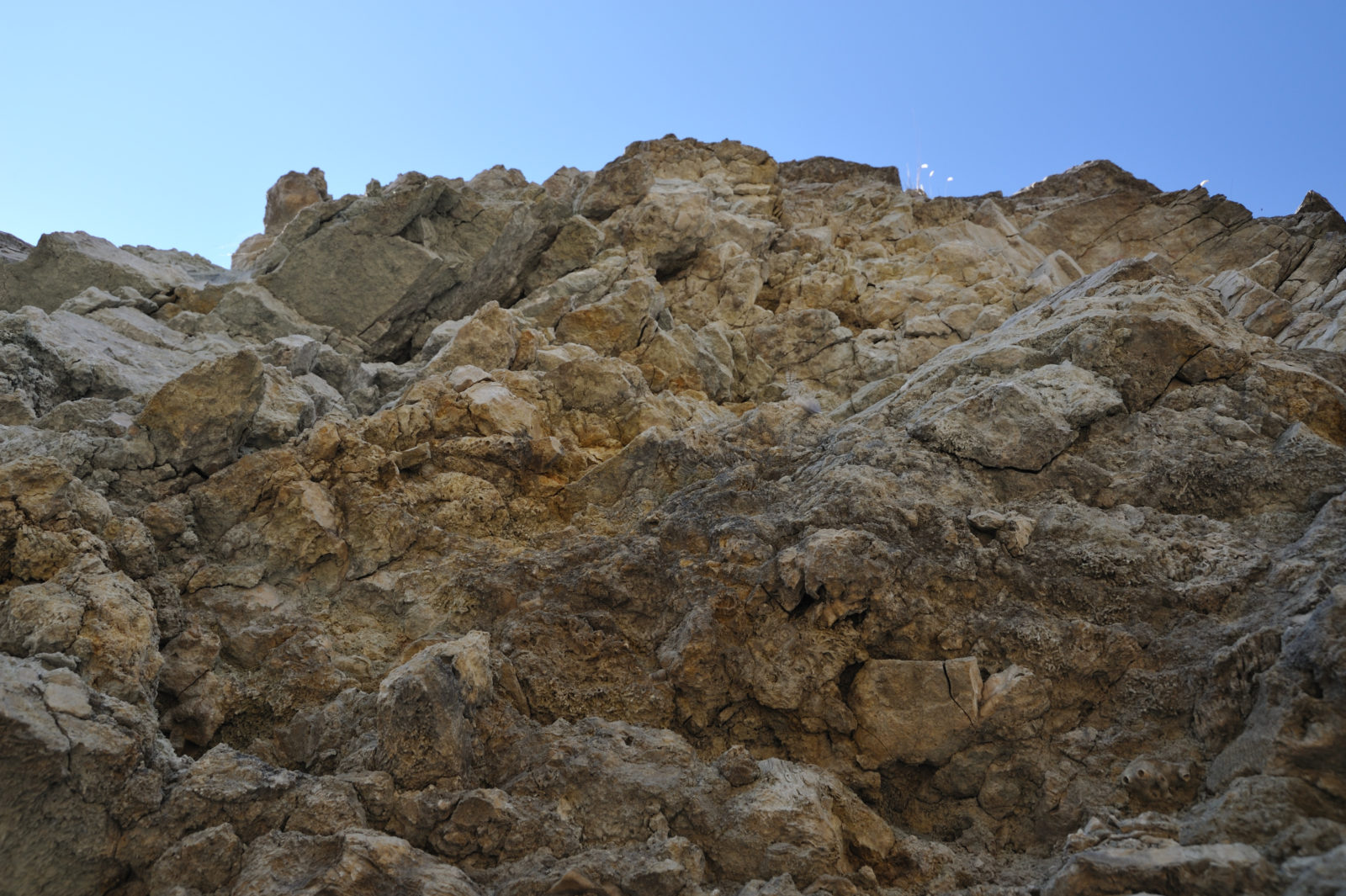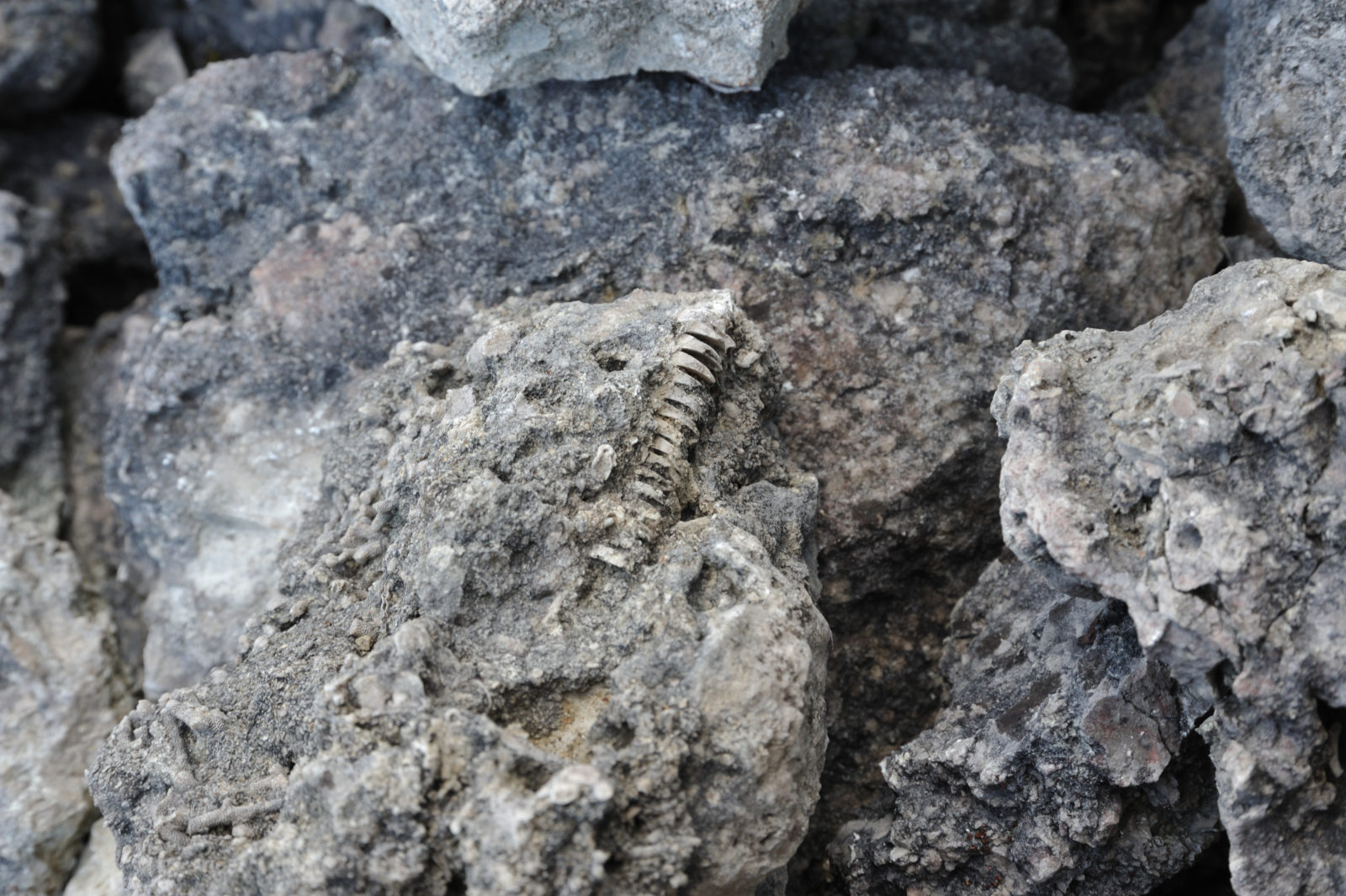Silurian Harvest
Post-Industrial Tropical Reefs on Northern Gotland
One of the most promising candidates for an Anthropocene Global Boundary Stratotype Section and Point is a short marine core from the Baltic Sea, taken from the Gotland Deep anoxic basin near the island of that same name. In this contribution, artists Nina Canell and Robin Watkins recover the deep-time aquatic past of the limestone environment that formed the island. Looking at what once were tropical reefs and now have become the building blocks of our modern industrial construction economy, they delineate the temporal entanglements between ancient life creation and modern-day living.
© Nina Canell and Robin Watkins
The processes that gave rise to the limestone and shale of the Baltic basin began south of the equator in what is now the South Pacific Ocean. Surrounding the paleocontinent Baltica, close to present-day Australia, a tropical environment supported vast reefs. From corals and sponges to cephalopods and conodonts, the Silurian consciousness was predominantly marine. In these shallow, hot, and salty conditions, the material aggregates of proto-Gotland started to interact and take shape.
Over time, sand and mud turned into marl and mudstone, preserving early living structures and storing their valuable mineral compositions as petrified ecosystems. As the continental cycle pushed Baltica into its current position, Gotland gradually rose out of Ancylus Lake about 10,000 years ago. This massive sweet water reservoir eventually joined with the North Sea via the Sound strait (Öresund), becoming the brackish Baltic Sea of today.
When the island surfaced, it revealed a composition of mainly limestone, a sedimentary rock formed through the hardened accumulation and cementation of organic particles. These particles have their origin in either the activities of communities in and around reefs or in the bodies and shells of the organisms themselves. As such, the island’s landmass is an archive of ancient environments, containing a high percentage of partial or complete fossil matter, interspersed within more processed calcite and aragonite mineral tissue. Since the main parent material of Gotland’s thin soils consists of calcareous till clay, its haptic terrain is directly linked to this material history.
These reserves were not only scraped into karstic rock formations by the elements but also modified, dug up, and landscaped by the resource-hungry industrial age. As pre-industrial quarries became larger and excavation methods grew increasingly aggressive, machine-based mining began to bore into the limestone bone at a new pace. Through drilling, slicing, and crushing, a by-product topography emerged secondary to the primary intention of these activities, leading to a kind of hardscaping of the land: an unintentional landscaping defined by extraction value. These upheavals revealed Gotland’s reef quarries as depositories of bygone bonds between ammonites, algae, crinoids, trilobites, bryozoa, mollusks, brachiopods, and many other vegetal-animal species of the Silurian age.
The economy of our own age has, however, conditioned how we interact with the material history of geological bodies and their bonds. When broken down into powder, these bodies yield calcium in carbonate, chloride, or oxide form, which are key ingredients of civilization as we know it—building blocks found in both single-use consumer items as well as vital to the construction of skyscrapers and entire cities. As commodity chemicals (additives in toothpaste, paper, plastics, paint, tiles, and other materials as white pigment and cheap filler) as well as industrial components (used in the cement industry, pulp mills, chemical industry, glass production, asphalt production, agriculture, sugar refineries, and ironworks), these life-forms-as-minerals are central to an economy of building.
By exposing these geological layers, anthropogenic minerals usage opens up a panorama of entanglements between ancient marine biomes and modern-day lifestyles. The quarries become an assemblage of different durations, of different yet interdependent natures. To bind real-life socioeconomic fluctuations to once living matter is key to understanding futurities in which bonds that are empathetic to our natural habitat can be established. But for now, the region is stuck in a troubled debate. Due to recent court rulings (2020), further mining of the largest cement quarry on Gotland has been put on hold, and as a result the entire building industry is currently expecting a crisis that will lead to material shortages and price inflation of raw materials. There is a conflict between environmentalists and industrialists concerning the expanded mining rights in light of the danger they pose to fresh water reserves, as well as the disturbances that continued mining would cause the unique ecosystems that support local flora and fauna. Instant consumption of long-term geochemical and biological processes speak of the precarity and tension inherent in the harvesting of Silurian consciousness.1
© Nina Canell and Robin Watkins © Nina Canell and Robin Watkins
This relatively brittle moment is not unparalleled. Earth’s first mass extinction event marked the beginning of the Silurian, around 443.8 million years ago. The climate was relatively warm and stable but gave way to a series of further perturbations, including minor mass extinctions as displayed in rock signals on Gotland: the Ireviken event, Mulde event, and Lau event. Retreating, and eventually nearly disappearing, glaciers lead to low continental landmasses and rising sea levels. Layers of fossil debris—limestone often made up of broken shells, known as “coquinas”—hint at the violent storms caused by warm surface water in the oceans. Then, as well as now, carbon and climate cycles were unsettled.
Out of this turbulence, life forms in the Rheic Ocean shaped the mineral-rich storage that makes up present-day paleo sea stacks, hills, and plains. The conditions of Gotland’s watery origin are still readable in the marl and mud of these unsettled industrial pits, where reefs have turned into a resource for ruins to come. Water and rock are primordial sculpting agents that negotiate in scales of softness and hardness—bulldozers and water cutters are tools that engage in the same material debate. But despite the frictious nature between human and nonhuman forces, the hybrid markers that are left behind places abiotic minerals, rock composites, and clay mixtures as essential material hosts for living, pulsing, biotic processes. To look at tropical reefs as building blocks of modern construction materials is to see living structures within modern construction materials. As mineral mixes with shell mixes with concrete-mixers mixes with feelings, the intermingling of process and tumbling of material time is folded into the ages.
© Nina Canell and Robin Watkins
Nina Canell and Robin Watkins are frequent collaborators. Grounded as much in the chance encounter as in close study, their sculptural process foregrounds material agency. Photographs by Nina Canell and Robin Watkins (all rights reserved). Text by Robin Watkins.
Please cite as: Canell, N and R Watkins (2022) Silurian Harvest. Post-Industrial Tropical Reefs on Northern Gotland. In: Rosol C and Rispoli G (eds) Anthropogenic Markers: Stratigraphy and Context, Anthropocene Curriculum. Berlin: Max Planck Institute for the History of Science. DOI: 10.58049/xrrg-pt40







